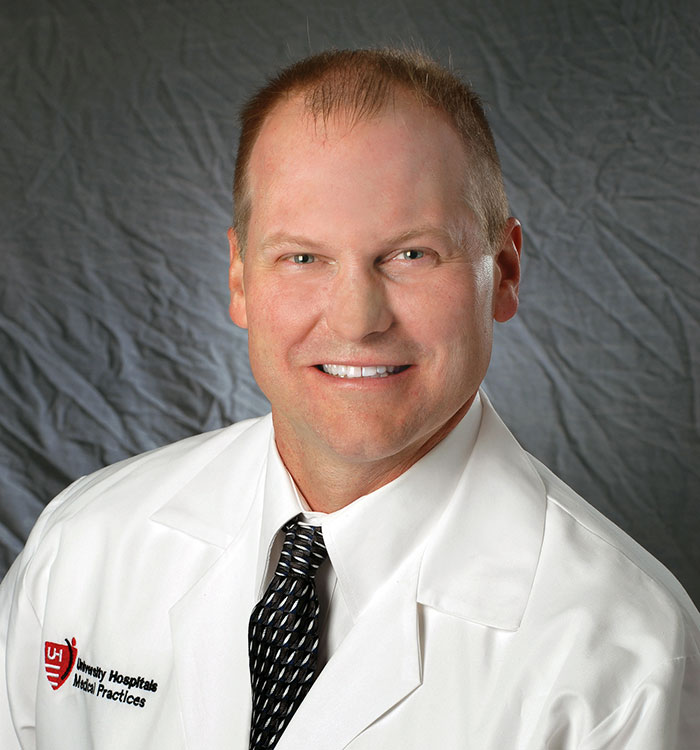Keeping an Eye on Controlled Substance Compliance
November 30, 2021
Sean Hoynes, MD, recent winner of a “Dinner with the Doc” award, is on the front lines at UH for combating the opioid crisis
UH Clinical Update | December 2021
The opioid crisis, both in Ohio and nationwide, has required physicians and other healthcare providers to take a fresh look at how they prescribe these and other controlled substances -- and how their patients use them. It’s a delicate balancing act, weighing the good these medicines can do in relieving pain and maintaining a patient’s quality of life against their well-established potential to be addictive, be diverted and lead to overdose deaths.
 Sean Hoynes, MD
Sean Hoynes, MDAt UH, one of the guiding influences for providers in navigating these concerns is the Quality Assurance Chart Review (QACR) process – a program developed with input from Quality, Risk Management, the UH Pain Management Institute and UH Primary Care Institute.
Sean Hoynes, MD, a family physician at UH Sharon Health Center in Medina, has been part of this work since 2015 – even before the formal process existed. He’s been conducting chart reviews and engaging with UH providers to educate them about how to comply with the myriad UH, state and federal guidelines, rules and laws concerning controlled substances.
“I have had the privilege of being a member of the UH Pain Management Institute and with the guidance from our director Dr. Jeanne Lackamp, we have been able to take this QACR process and apply it across our entire system,” Dr. Hoynes says. “Dr. Lackamp has been our guiding force in making this a successful QACR process.”
How does this work in real terms? Advancements in data analytics allow Dr. Hoynes and his Risk Management colleague Heidi DelVecchio BSN, RN, CPHQ, Senior Risk Management Officer Team Lead for UHPS, to monitor providers’ prescribing practice and identify those primary care and specialty care providers who need additional education on what can be a complicated topic. Ed Kay, BSN, RN, Senior Quality Improvement Nurse, and Joshua Brown, MHA, Quality Specialist, provide the team with data support in preparation for the educational sessions.
To underscore their importance, these sessions occur in person, over a one-hour period.
“Before meeting, we spend a couple hours reviewing the provider’s prescribing habits and identify illustrative examples,” Dr. Hoynes says. “After the hour-long session, we continue to monitor the provider every 90 days.for a year. If they change their practice, they get positive reinforcement with an email. If they don’t, they get more education. The goal is always to make sure we’re keeping patient safety as our number one concern and following all the guidelines UH and the state have put out for us.”
Dr. Hoynes was recently recognized for this important work with a “Dinner with the Doc” award from UH CEO Cliff Megerian, MD.
In describing this ongoing project, Dr. Hoynes is quick to point out that the purpose is squarely aimed at quality improvement, and to accomplish this through educational rather than punitive means. The team behind the QACR process, for example, has produced an online toolkit of resources for providers on different controlled substance topics. The in-person sessions focus on practical, actionable items, such as how to use the EMR to create a patient’s controlled substance agreement, which urine drug screen to order for a patient and a reminder to prescribe Narcan along with the opioids for a patient for use in overdose emergencies.
The goal, Dr. Hoynes says, is to prevent providers from simply swearing off prescribing controlled substances because it’s “too complicated.”
“We always emphasize that a patient might need that controlled substance to enhance the quality of their life,” he says.
One important component of provider education regarding patients on opioids, in particular, is also highlighting the alternatives now available through the UH Pain Management Institute, Dr. Hoynes says.
“We have a very comprehensive, robust pain management program at UH through the UH Pain Management Institute,” he says. “It’s a whole new way of looking at folks with pain. We make sure that all of our providers are very well aware of it.”
As the QACR work continues, Dr. Hoynes says he’s gratified for the support the team has received from UH leadership.
“We’ve had overwhelming support from Dr. Megerian and all the chiefs and chairs,” he says.
Health systems outside UH are even noticing the robust process in place here, he says.
When I’ve spoken with colleagues outside the UH system, I don’t think anyplace provides this type of support,” Dr. Hoynes says. “I think our system is ahead of the curve in helping our providers.”
Congratulations to Dr. Hoynes on his “Dinner with the Doc” award.
To nominate a UH physician caregiver for this award, please visit https://uhcommunity.uhhospitals.org/News/Documents/Cliff_Appreciates_Dinner_w_Doc_Nomination_Form-_FINAL.pdf.


